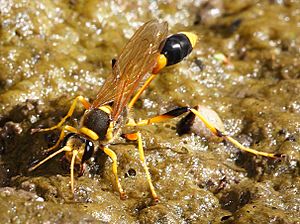Sceliphron laetum facts for kids
Sceliphron laetum is a type of wasp known as a mud-dauber wasp. These wasps are special because they build nests out of mud! They are solitary, meaning they live alone, not in big groups like some other wasps. Female wasps build mud cells to raise their babies. They fill these cells with spiders they have paralyzed, then lay an egg inside. You can find these wasps in Australia and parts of southeastern Asia.
Quick facts for kids Sceliphron laetum |
|
|---|---|
 |
|
| Scientific classification | |
| Kingdom: | |
| Phylum: | |
| Class: | |
| Order: | |
| Family: |
Sphecidae
|
| Genus: |
Sceliphron
|
| Species: |
S. laetum
|
| Binomial name | |
| Sceliphron laetum F. Smith, 1856
|
|
Contents
What Does the Mud-Dauber Wasp Look Like?
Sceliphron laetum wasps are usually between 17 and 26 millimeters (about 0.7 to 1 inch) long. They are mostly black with bright yellow markings. Their wings are thin and fold neatly over their body when they are resting.
Body Features of the Wasp
The wasp's head has yellow hairs, especially on top. Unlike a similar wasp, Sceliphron formosum, this wasp does not have a bare yellow patch on its lower face. Its middle body part, called the thorax, often has yellow spots between its wings.
A unique part of this wasp's body is its very thin, long waist, called a petiole. This petiole and the front part of its abdomen are yellow. The main, round part of its abdomen is black, with a yellow tip. Its legs are yellow with some black marks.
Where Do Mud-Dauber Wasps Live?
The Sceliphron laetum wasp is native to most parts of Australia. You can also find it in some areas of southeastern Asia, including Papua New Guinea.
How Mud-Dauber Wasps Build Nests and Reproduce
Female Sceliphron laetum wasps are amazing builders! They create many tube-shaped cells using mud. These cells are grouped together to form a nest. Once the nest is finished, the wasp adds more mud to make bumpy ridges on the outside.
Providing Food for Young Wasps
After building a cell, the female wasp collects several spiders. She stings them to make them paralyzed, so they can't move. She then places these spiders inside the cell. On the very first spider, she lays a single egg.
Once the egg is laid and the spiders are inside, she seals the cell's entrance with more mud. Then, she starts building and filling another cell. A female wasp can lay about eight eggs in her lifetime.
Wasp Life Cycle in the Nest
When the egg hatches, a tiny wasp larva (baby wasp) emerges. This larva eats all the spiders in its cell. After it has eaten enough, it changes into a pupa. Finally, the pupa grows into an adult wasp. The new adult wasp then chews its way out of the mud cell to fly free.
What Spiders Do They Choose?
These wasps often choose orb-weaving spiders as food for their young. Scientists have found that the wasps are picky about which spiders they use. They often lay their egg on a softer spider, like those from the Argiope or Neoscona groups.
However, a spiny orb-weaver spider (Gasteracantha) is often used in the cell later, but the egg is rarely laid on it. Scientists think this is because the spiny orb-weaver's tough body might be too hard for a very young wasp larva to eat.
The number of spiders in each cell can be different, usually from three to nine. The wasp seems to choose the number of spiders based on their total weight, not just how much space they take up. Wasps can also decide if their offspring will be male or female when they lay the egg. Male wasps are smaller than females, but they don't necessarily get less food.

